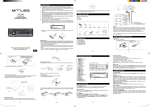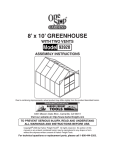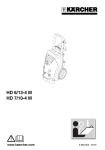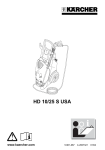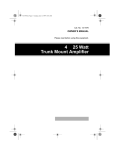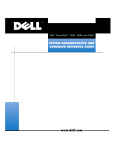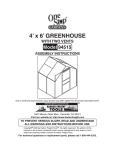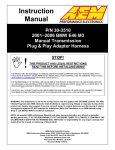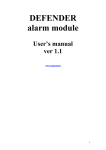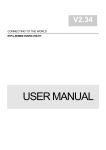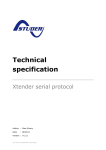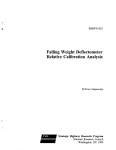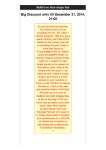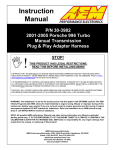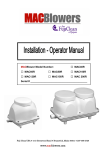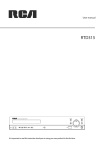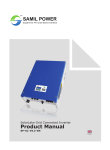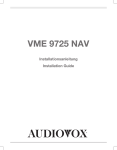Download DEFENDER ABS-TC module User`s manual ver 1.1
Transcript
DEFENDER ABS-TC module User’s manual ver 1.1 www.nanocom.it 1 INDEX 1.1 INTRODUCTION................................................................................................................................... 3 1.2 GENERAL INFORMATION.................................................................................................................. 3 2 STANDALONE MODE ............................................................................................................................ 4 2.1 MENU DEF. ALLARM.......................................................................................................................... 4 2.2 READ FAULTS FUNCTION ................................................................................................................. 4 2.3 CLEAR FAULT CODE FUNCTION ..................................................................................................... 5 2.4 INPUTS FUNCTION.............................................................................................................................. 5 2.7 OUTPUTS FUNCTIONS........................................................................................................................ 6 2.8 FRONT LEFT TEST FUNCTION.......................................................................................................... 7 2.9 FRONT RIGHT TEST FUNCTION ....................................................................................................... 7 2.10 REAR LEFT TEST FUNCTION .......................................................................................................... 7 2.11 REAR RIGHT TEST FUNCTION........................................................................................................ 7 2.12 POWER BLEED FUNCTION .............................................................................................................. 7 2.13 MODULATOR BLEED FUNCTION................................................................................................... 8 3 REMOTE MODE....................................................................................................................................... 9 3.1 READ FAULTS FUNCTION ................................................................................................................. 9 3.10 POWER BLEED FUNCTION ............................................................................................................ 13 3.11 MODULATOR BLEED FUNCTION................................................................................................. 13 3.2 CLEAR FAULTS FUNCTION............................................................................................................... 9 3.3 OPEN FAULT FILE FUNCTION ........................................................................................................ 10 3.4 READ INPUTS FUNCTION ................................................................................................................ 10 3.5 OUTPUTS FUNCTIONS...................................................................................................................... 12 3.6 FRONT RIGHT TEST FUNCTION ..................................................................................................... 12 3.7 FRONT LEFT TEST FUNCTION........................................................................................................ 12 3.8 REAR RIGHT TEST FUNCTION........................................................................................................ 12 3.9 REAR LEFT TEST FUNCTION .......................................................................................................... 13 APPENDIX ................................................................................................................................................. 14 TABLE 1: COMPLETE FAULT CODE LIST ........................................................................................... 14 2 1.1 INTRODUCTION In this manual only the diagnostic functions related to DEFENDER ABS are described and it’s taken for garanted that the user knows the NANOCOM basic functions concerning how to explore the menus and how to manage the NANOCOM-generated files. It’s thus recommended to carefully read the document “NANOCOM user manual.pdf” where these subjects are dealt with. 1.2 GENERAL INFORMATION Like the diagnostic functions related to engine TD5’s management, NANOCOM allows to perform diagnostic functions related to DEFENDER alarm in STANDALONE mode, that is completely independent from the PC usage by visualizing the interactive functions on the display on the NANOCOM interface, or in REMOTE mode by employing the application NANOCOM.exe for PC. As for the STANDALONE mode, once NANOCOM is running it is necessary to press key 3 or key 4 (<< >>) until the display shows the writing “DEF. ABS” in order to have access to the alarm diagnostic functions. At this point, key 1 “ent” allows to have access to the submenu containing the various functions and described in section 2.1. In REMOTE mode, instead, you have to press button DEF. ABS in the exploration area which allows to expand the buttons that start the diagnostic functions described in chapter . NOTA: To make NANOCOM communicate with ABS ECU, like with the TD5 ECU diagnostic functions, the ignition has to be on. 3 2 STANDALONE MODE In this chapter it’s described how to use the diagnostic functions in STANDALONE mode, that is without using the PC. The user is thus recommended to read paragraphs 4.1.1-4.1.2-4.1.3 describing this mode and all paragraphs of section 4.3 explaining how to manage th files; section 4.5 dealing with file saving; and the 4.7 concerning error messages. 2.1 MENU DEF. ALLARM The following tree diagram shows the structure of this submenu: DEFENDER ABS READ EVENT CLEAR EVENT INPUTS OUTPUTS FRONT RIGHT IN FRONT RIGHT OUT FRONT LEFT IN FRONT LEFT OUT REAR RIGHT IN REAR RIGHT OUT REAR LEFT IN REAR LEFT OUT PUMP RELAY VALVE REALY BRAKE WARN. LED ABD WARN. LED T.C. LAMP SPEEDO HDC INFO LED HDC FAULT LED FRONT LEFT TEST FRONT RIGHT TEST REAR LEFT TEST REAR RIGHT TEST ABS POWER BLEED ABS MODUL. BLEED In this menu the keys perform the following functions: Key 1: ent Key 2: esc Key 3: “←←” Key 4: “→→” ENTER (gets the function started, or gets into the submenu in case you choose the item “OUTPUT”) ESCAPE (gets back to the level of the preceding menu). scrolling the menu backward scrolling the menu forward 2.2 READ FAULTS FUNCTION The ABS ECU contains a register which memorizes the faults detected by the system and the number of times these are detected, making a distinction between intermittent errors faults and current faults. Once key 1 “ent” has been pressed at the menu item READ FAULTS, the writing “Read faults?” appears on the display: pressing key 1 “yes” the function gets started, whereas pressing key 4 “not” you get back to the menu without performing the function. If the communication is correct, the LED will flash, and if the function is completely performed, the display will show the list of the events. The faults are listed with the numeric codes. To get to know the meanings of the numeric code see appended table 1. 4 At this point the keys have the following functions: Key 1: Key 2: esc Key 3: “bak” Key 4: “→→” no function ESCAPE (gets to the level of the previous menu). gets to the first code goes on to the following code To get to the main menu press “esc” or scroll through all the listed events by using key 4: in both cases, before getting to the main menu the writing “Save this file?” appears on the display. Pressing key 1 “yes” you store a file containing the faults triggered by the ECU; whereas pressing key 4 “not” you get back straight to the menu. The file generated is stored in NANOCOM’s memory with extention .fa3, it will thus be possibile to visualize these faults later in text format transferring this file on the PC. The faults are featured as follows: AA-B NNN Where ‘AA-B’ is the number of the fault, and NNN is the number of times the fault has been detected 2.3 CLEAR FAULT CODE FUNCTION Once the key 1 “ent” has been pressed at the menu item CLEAR FAULT, the writing “Clear faults?” will appear on the display: pressing key 1 “yes” the function gets started, whereas pressing key 4 “not” you get back to the menu without performing the function. If the communication is on, the LED will flash, and if the function is correctly performed, the display will show the writing “the fault codes have been cleared". At the end of the function, you don’t need to press any key, NANOCOM gets automatically to the menu. 2.4 INPUTS FUNCTION Once the key 1 “ent” has been pressed at the menu item INPUTS, the writing “Read inputs?” will appear on the display: pressing key 1 “yes” the alarm input reading function gets started, where as pressing key 4 “not” you get back to the menu without performing the function. This function scans continously all the inputs with the frequency of about one second. If the communication is on, the LED will flash continously for as long as the scan is performed. At this point the keys perform the following functions: Key 1: Key 2: stop Key 3: “←←” Key 4: “→→” no function stop the scanning. show previous parameter show following parameter The different parameters are shown one by one on the first line of the display. The parameters of which the scanning is performed are the following: FLSens(Front Left sensor) FRSens(Front Right sensor) RLSens(Rear Left sensor) RRSens(Rear Right sensor) Value (volts) of the front left sensor Value (volts) of the front right sensor Value (volts) of the rear left sensor Value (volts) of the rear right sensor FLOV(Front Left outlet valve) FROV(Front Left outlet valve) RLOV(Rear Left outlet valve) RROV(Rear Right outlet valve) FLIV(Front Left inlet valve) FRIV(Front Right inlet valve) RLIV(Rear Left inlet valve) RRIV(Rear Right inlet valve) Driving value of the front right outlet valve Driving value of the front left outlet valve Driving value of the rear left outlet valve Driving value of the rear right outlet valve Driving value of the front left inlet valve Driving value of the front right inlet valve Driving value of the rear left inlet valve Driving value of the rear right inlet valve 5 FLWS(Front Left Wheel speed) FRWS(Front Right Wheel speed) RLWS(Rear Left Wheel speed) RRWS(Rear Right Wheel speed) Speed value detected on the front left wheel Speed value detected on the front right wheel Speed value detected on the rear left wheel Speed value detected on the rear right wheel Eng. speed(Engine speed) Eng. torque(Engine torque) Throt. Pos(throttle position) Brake light Pump Relay Ign. Relay(ignition relay) Valve sup.(Valve supply) PMV(Pump monitor voltage) GND ref.(Ground reference) Shut.sw(Shuttle switch) Engine speed Engine torque in percentage Throttle position Driving value of the brake light relay Driving value of the pump relay Driving value of the ignition relay Value of the valve supply Value of the pump monitor voltage Value (volts) ground reference Shuttle switch 2.7 OUTPUTS FUNCTIONS These functions are in a submenu of the menu DEF. ABS, so when the display shows the item OUTPUTS, pressing key 1 “ent” you get to the submenu containing the following items. Each of these items allows to activate the test of the corresponding output. FRONT RIGHT IN FRONT RIGHT OUT FRONT LEFT IN FRONT LEFT OUT REAR RIGHT IN REAR RIGHT OUT REAR LEFT IN REAR LEFT OUT PUMP RELAY VALVE REALY BRAKE WARN. LED ABS WARN. LED T.C. LAMP SPEEDO HDC INFO LED HDC FAULT LED Activates or deactivates the front right inlet valve Activates or deactivates the front right outlet valve Activates or deactivates the front left inlet valve Activates or deactivates the front left outlet valve Activates or deactivates the rear right inlet valve Activates or deactivates the rear right outlet valve Activates or deactivates the rear left inlet valve Activates or deactivates the rear left outlet valve Activates the ABS pump relay Activates the ABS valve relay Activates the brake warning led Activates the ABS warning led Activates the TD lamp Activates the output of the tachometer with a reference of 100 mph Activates the lamp indicating that the HDC system is on Activates the HDC mil lamp You’ll perform the function by pressing key 1 “ent”. Now the keys will acquire the following functions: Key 1: esc Key 2: Key 3: “on” Key 4: “off” leaves the function no function activates the test stops the test Once within the function, you’ll activate the test by pressing key 3 “on”. You keep on performing it until you press key 4 “off” or you leave the function through key 1 “esc”. 6 2.8 FRONT LEFT TEST FUNCTION This function allows to perform a test of the front left wheel brake. Once the key “ent” has been pressed at the menu item FRONT LEFT TEST, the writing “FrontLeft test?” will appear on the display. Pressing key 1 “yes” you’ll start the function, whereas pressing key 4 “not” you’ll get back to the menu without performing the function. If the communication is on, the LED will flash and the wheel brake will be activated for about 10 seconds; if the function is ended properly, the display will show the writing “Test done". At the end of the function you don’t need to press any key, NANOCOM will automatically get back to the menu. 2.9 FRONT RIGHT TEST FUNCTION This function allows to perform a test of the front right wheel brake. Once the key “ent” has been pressed at the menu item FRONT RIGHT TEST, the writing “FrontRight test?” will appear on the display. Pressing key 1 “yes” you’ll start the function, whereas pressing key 4 “not” you’ll get back to the menu without performing the function. If the communication is on, the LED will flash and the wheel brake will be activated for about 10 seconds; if the function is ended properly, the display will show the writing “Test done". At the end of the function you don’t need to press any key, NANOCOM will automatically get back to the menu. 2.10 REAR LEFT TEST FUNCTION This function allows to perform a test of the rear left wheel brake. Once the key “ent” has been pressed at the menu item REAR LEFT TEST, the writing “RearLeft test?” will appear on the display. Pressing key 1 “yes” you’ll start the function, whereas pressing key 4 “not” you’ll get back to the menu without performing the function. If the communication is on, the LED will flash and the wheel brake will be activated for about 10 seconds; if the function is ended properly, the display will show the writing “Test done". At the end of the function you don’t need to press any key, NANOCOM will automatically get back to the menu. 2.11 REAR RIGHT TEST FUNCTION This function allows to perform a test of the rear right wheel brake. Once the key “ent” has been pressed at the menu item REAR RIGHT TEST, the writing “RearRight test?” will appear on the display. Pressing key 1 “yes” you’ll start the function, whereas pressing key 4 “not” you’ll get back to the menu without performing the function. If the communication is on, the LED will flash and the wheel brake will be activated for about 10 seconds; if the function is ended properly, the display will show the writing “Test done". At the end of the function you don’t need to press any key, NANOCOM will automatically get back to the menu. 2.12 POWER BLEED FUNCTION This function allows to perform the ABS primary circuit bleeding. Once the key “ent” has been pressed at the menu item POWER BLEED, the writing “PowerBleed?” will appear on the display. Pressing key 1 “yes” you’ll start the function, whereas pressing key 4 “not” you’ll get back to the menu without performing the function. If the communication is on, the LED will flash and the pump will be activated for about 4 seconds allowing the bleeding of the primary circuit; if the function is ended properly, the display will show the writing “Test done". At the end of the function you don’t need to press any key, NANOCOM will automatically get back to the menu. 7 2.13 MODULATOR BLEED FUNCTION This function allows to perform the ABS secondary circuit bleeding. Once the key “ent” has been pressed at the menu item MODULATOR BLEED, the writing “ModulatorBleed?” will appear on the display. Pressing key 1 “yes” you’ll start the function, whereas pressing key 4 “not” you’ll get back to the menu without performing the function. If the communication is on, the LED will flash and the pump will be activated for about 4 seconds allowing the bleeding of the secondary circuit; if the function is ended properly, the display will show the writing “Test done". At the end of the function you don’t need to press any key, NANOCOM will automatically get back to the menu. 8 3 REMOTE MODE In this chapter it is described how to employ the diagnostic functions in REMOTE mode, that is using the PC; it is recommended to read paragraphs 5.1.1-5.1.2-5.1.3 describing this mode, and all the paragraphs of section 4.3 about files and memory management, and 4.6 concerning error messages. 3.1 READ FAULTS FUNCTION Clicking the button “Read faults” you start the read faults function. If the function is ended properly after a few seconds the list of the stored events will appear in the input-output data area. The picture shows some examples: In the input-output data area, at the end at the events list, also two buttons will appear which allow to create a file in the PC memory, containing the read files. The button “Save fault code in a NANOCOM file (*.fa3) ” saves a file with extention .fa3 (the same generated by NANOCOM in standalone mode). This kind of file is only visible from the application NANOCOM.exe. The button “Save faults in a text file (*.txt)” saves a text file containing the fault list. Once stored, this text file can be opened with any text editor and thus printed. 3.2 CLEAR FAULTS FUNCTION Clicking the button “Clear faults” you start the clear faults function. If the function is ended properly after a few seconds the following window will appear, indicating that the function has been successfully performed: 9 3.3 OPEN FAULT FILE FUNCTION This function offers the possibility to open a file *.fa3, thus allowing to visualise the faults contained in a file previously saved. Using NANOCOM in standalone mode you can read the faults register and store the contents in a file, which will be found in NANOCOM memory even after it has been switched off. In a later moment, it will thus be possible to transfer this file to the PC through the “file manager” utility to create a copy of it and open it through this function which will visualise the code contained in the file, or open it directly without importing it to the PC. This allows to do diagnostics without necessarily having a laptop, or to store the ECU state in a given moment, even if you are distant from your house, workshop, etc. Clicking the button “Open fault file” a dialogue window will appear offering you to choose whether to open a file contained in NANOCOM or on the PC. If you choose to open a file contained in NANOCOM, a window will show the files in it. To open the file you want, select one of the files and click the button “OK”. If you want to open a file contained in the PC, a file browser will appear offering you to choose among the files in the PC. The faults are visualised in the same way as in the Read faults function, and here too it’s possible to save a text-format file. 3.4 READ INPUTS FUNCTION Clicking the button “Read inputs” you start function that reads the ABS inputs state. If the function is performed properly NANOCOM will show the input state in the interactive input-output area. The meaning of these inputs is described in section 2.3 dealing with the INPUTS function in standalone mode. The reading of the inputs state is performed uninterruptedly. To stop the function you have to click the button “Stop”. 10 3.5 OUTPUTS FUNCTIONS Clicking the button “Test Outputs”, the buttons that allow to start the ECU outputs tests are shown in the input-output area. Each of these buttons activates or deactivates the corresponding output. The single outputs tests are described in section 2.4 dealing with these functions in standalone mode. 3.6 FRONT RIGHT TEST FUNCTION This function allows to perform a front right wheel brake test. Once the button “Front Right test” has been clicked, the function is activated; if the communication is properly performed, the wheel brake will be activated for about 10 seconds. A dialog window will indicate that the system will be busy until the NANOCOM interface completes the test. 3.7 FRONT LEFT TEST FUNCTION This function allows to perform a front left wheel brake test. Once the button “Front Left test” has been clicked, the function is activated; if the communication is properly performed, the wheel brake will be activated for about 10 seconds. A dialog window will indicate that the system will be busy until the NANOCOM interface completes the test. 3.8 REAR RIGHT TEST FUNCTION This function allows to perform a rear right wheel brake test. Once the button “Rear Right test” has been clicked, the function is activated; if the communication is properly performed, the wheel brake will be activated for about 10 seconds. A dialog window will indicate that the system will be busy until the NANOCOM interface completes the test. 11 3.9 REAR LEFT TEST FUNCTION This function allows to perform a rear left wheel brake test. Once the button “Rear left test” has been clicked, the function is activated; if the communication is properly performed, the wheel brake will be activated for about 10 seconds. A dialog window will indicate that the system will be busy until the NANOCOM interface completes the test. 3.10 POWER BLEED FUNCTION This function allows to perform ABS primary circuit bleeding. Once the button “Power bleed” has been clicked, the function is activated; if the communication is properly performed, the pump will be activated for about 4 seconds allowing the circuit bleeding. A dialog window will indicate that the system will be busy until the NANOCOM interface completes the operation. 3.11 MODULATOR BLEED FUNCTION This function allows to perform ABS secondary circuit bleeding. Once the button “Modulator bleed” has been clicked, the function is activated; if the communication is properly performed, the pump will be activated for about 4 seconds allowing the circuit bleeding. A dialog window will indicate that the system will be busy until the NANOCOM interface completes the operation. 12 APPENDIX TABLE 1: COMPLETE FAULT CODE LIST 01,2: pump failure 1 (monitor line) 01,3: pump failure 2 (pump not running when actuated) 01,4: pump failure 3 (pump sticking) 01,5: pump failure 4 (pump running when not actuated) 01,6: shuttle valve switch failure 01,7: ecu internal valve relay fault 02,0: no battery supply voltage 02,1: pwm signal failure from engine ecu 02,2: ecu ground or reference ground fault 02,4: front right sensor offset voltage out of range 02,5: rear left sensor offset voltage out of range 02,6: front left sensor offset voltage out of range 02,7: rear right sensor offset voltage out of range 03,0: front right inlet valve open circuit 03,1: front right outlet valve open circuit 03,2: front left inlet valve open circuit 03,3: front left outlet valve open circuit 03,4: rear right inlet valve open circuit 03,5: rear right outlet valve open circuit 03,6: rear left inlet valve open circuit 03,7: rear left outlet valve open circuit 04,0: pump relay open circuit 04,4: front right sensor output too low 04,5: rear left sensor output too low 04,6: front left sensor output too low 04,7: rear right sensor output too low 05,0: front right inlet valve short to ground 05,1: front right outlet valve short to ground 05,2: front left inlet valve short to ground 05,3: front left outlet valve short to ground 05,4: rear right inlet valve short to ground 05,5: rear right outlet valve short to ground 05,6: rear left inlet valve short to ground 05,7: rear left outlet valve short to ground 06,0: pump relay short to ground 06,4: front right sensor electrical failure 06,5: rear left sensor electrical failure 06,6: front left sensor electrical failure 06,7: rear right sensor electrical failure 07,0: front right inlet valve short to internal supply 07,1: front right outlet valve short to internal supply 07,2: front left inlet valve short to internal supply 07,3: front left outlet valve short to internal supply 07,4: rear right inlet valve short to internal supply 07,5: rear right outlet valve short to internal supply 07,6: rear left inlet valve short to internal supply 07,7: rear left outlet valve short to internal supply 08,0: pump relay short to internal supply 08,4: front right sensor output intermittent 08,5: rear left sensor output intermittent 08,6: front left sensor output intermittent 08,7: rear right sensor output intermittent 09,0: front right inlet valve drive short to supply 09,1: front right outlet valve drive short to supply 09,2: front left inlet valve drive short to supply 09,3: front left outlet valve drive short to supply 13 09,4: rear right inlet valve drive short to supply 09,5: rear right outlet valve drive short to supply 09,6: rear left inlet valve drive short to supply 09,7: rear left outlet valve drive short to supply 10,0: pump relay drive short to supply 11,0: sticking throttle detected 11,4: shuttle valve switch electrical failure 14














